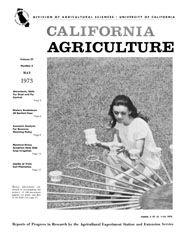


University of California
California Agriculture
|
|||
|
|||

Cover:
Rotary olfactometer employed in investigating the potency of tele-attractants against eye gnats and flies in the field.
May 1973
Volume 27, Number 5 News and opinion |
|||
|
University of California, 1301 S. 46th St., Bldg. 478 Richmond, CA
|